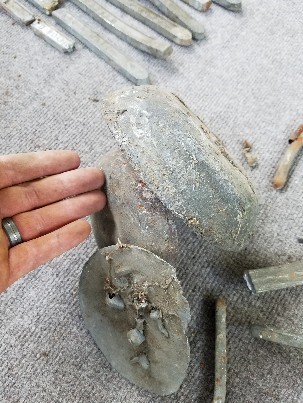Good morning and congratulations on your gift. I am going to copy and paste your question so I can break it up into parts and make suggestions on how to handle this. DO NOT MIX IT ALL TOGETHER INTO ONE BATCH!
"A log time friend of mine just gave me 59 pounds of lead. Some of it is in forms of 50% lead
-If you can ID it as soft lead, like lead pipe and such, then put that in one container for sorting and mark it "soft or pure lead"
50% tin rods for soldering and some 40%-60%.
-Generally we call 50% tin rods "50/50 solder" and since the other is 40/60 solder that is probably going to be good to keep separated as well.
There is also chunks of pure lead as well as what looks to be a piece of lead pipe and other rod like pieces that dont have any identifications on them, they are however harder and make a cracking sound when I bend them.
-You talking about rod like pieces that are harder and make a cracking sound when you bend them. Perhaps they are also more shiny? This crackle is called "tin cry" so that is nearly pure tin, and will require another container for sorting purposes.
-I also saw some odd pieces of some kind of two piece clamp like fitting. Those might not be good lead for casting. That will require you to melt it and see if it will even cast. I would be suspect on that much like the lead anchors used in concrete or sometimes battery cables that might contain zinc. If it has zinc, it will show up when you melt it as the foam on the surface will develop and the melt is really nasty and goopy.
I really have know idea how to use this mixture of alloys properly for casting bullets. I have done thousands of cast bullets prior but they were just plain old lead wheel weights I got from local garages. Does anyone here use stuff like this and if so how use to cast/mix with ww/ use by themselves?
-If you have left over bits and pieces, perhaps melting separately will allow you to pour some small ingots and keep the unknown ingots together. If you ladle pour, then cast some sample bullets from a mold of known production. Compare weight. If lighter, they have more tin or antimony. If heavier, then they have a higher percentage of lead. You can also compare hardness if you have bullet samples from the same mold. works best with a flat nosed bullet. Place the known and the unknown sample in a vise with smooth jaws so that the flat noses are together. Squeeze, and the softer alloy will become shorter than the harder alloy. This will give you a good start in sorting and identifying your plunder.













